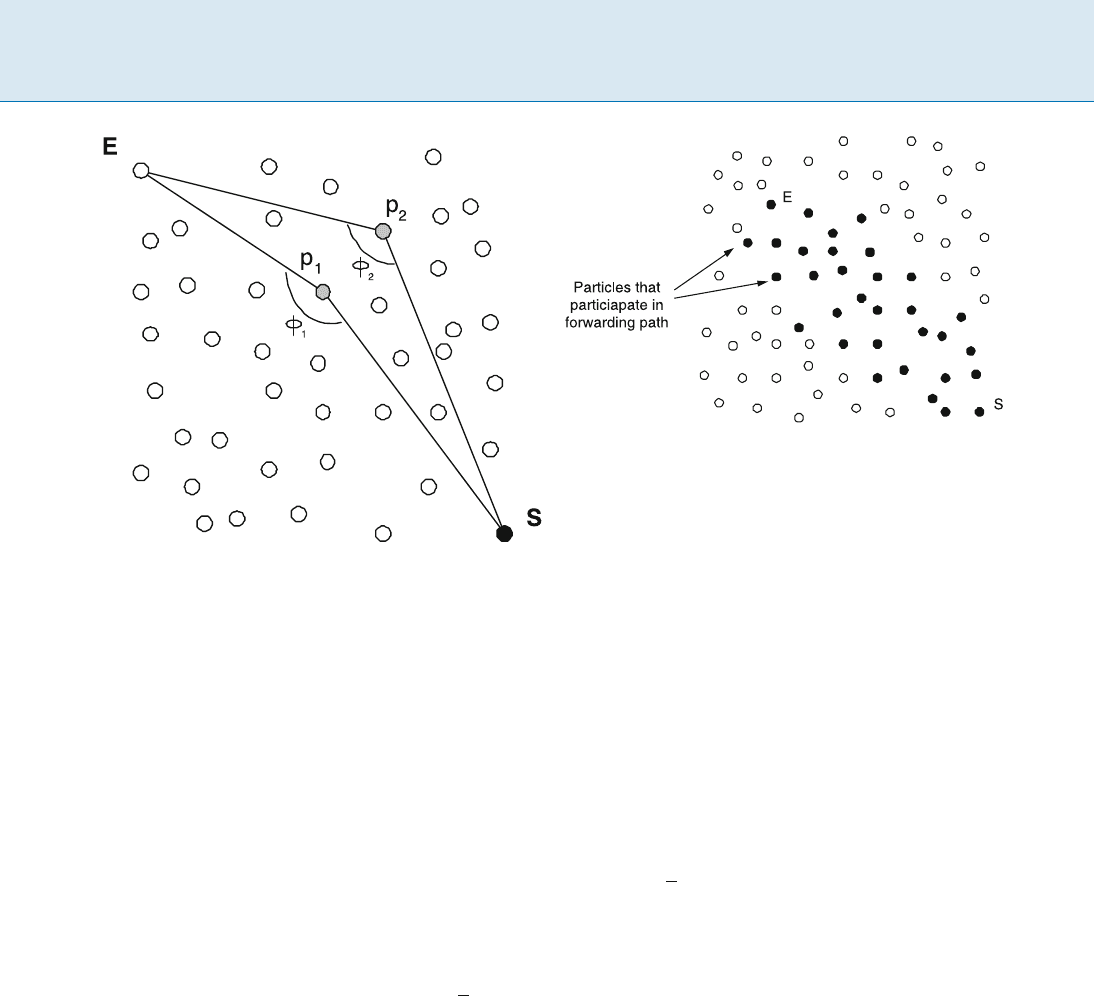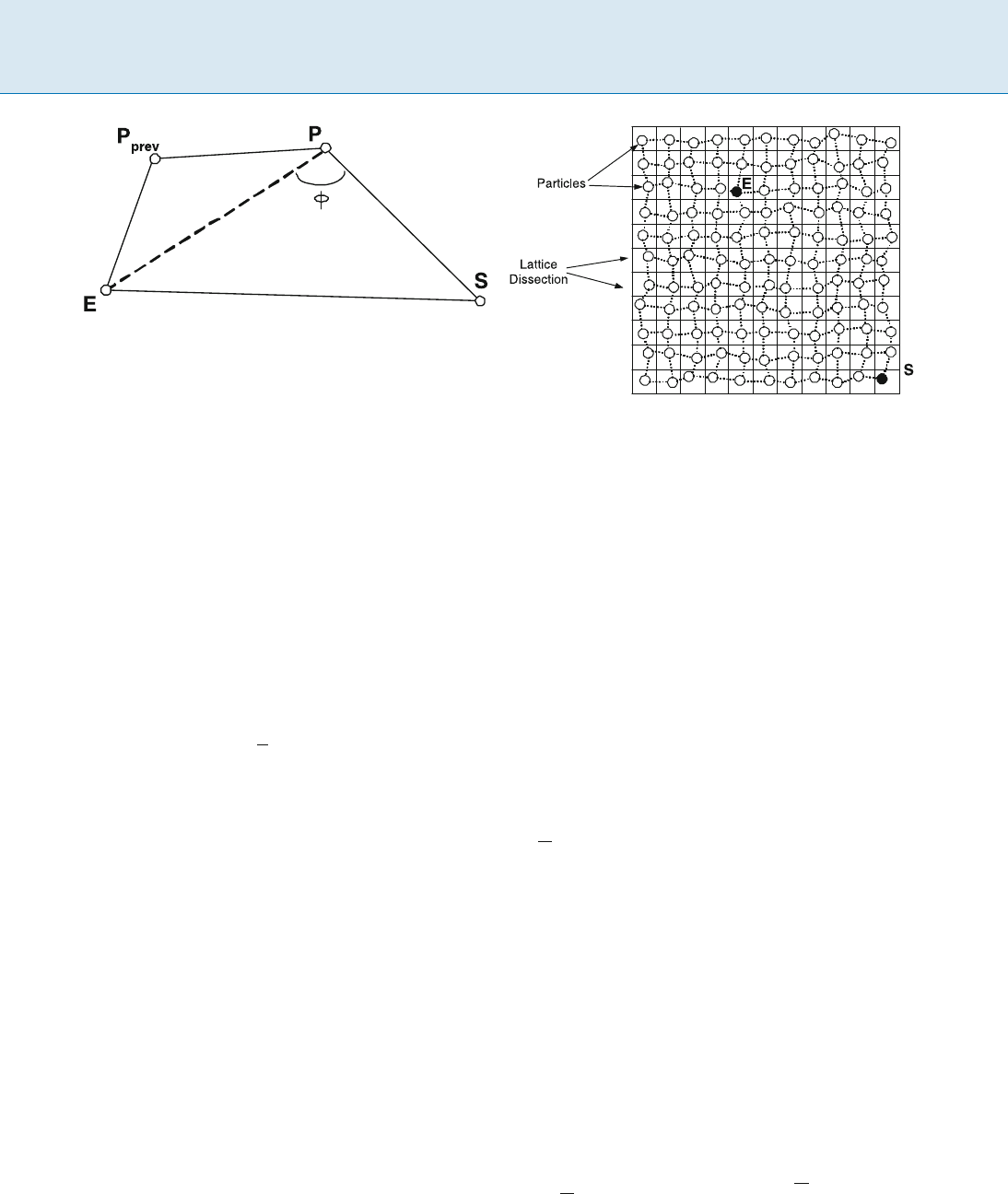Kao M.-Y. (ed.) Encyclopedia of Algorithms
Подождите немного. Документ загружается.


668 P Price of Anarchy for Machines Models
speeds s
1
;:::;s
m
and n independent tasks with weights
w
1
;:::;w
n
. The goal is to allocate the tasks to the ma-
chines to minimize the maximum load of the links in the
system.
It is assumed that all tasks are assigned by non-co-
operativeagents.Thesetofpure strategies for task i is the
set f1;:::;mgand a mixed strategy is a distribution on this
set.
Given a combination (j
1
;:::; j
n
) 2f1;:::;mg
n
of
pure strategies, one for each task, the cost for task i
is
P
j
k
=j
i
w
k
s
j
i
, which is the time needed for machine j
i
chosen by task i to complete all tasks allocated to that
machine. Similarly, for a combination of pure strategies
(j
1
;:::; j
n
) 2f1;:::;mg
n
,theload of machine j is defined
as
P
j
k
=j
w
k
s
j
.
Given n tasks of length w
1
;:::;w
n
and m machines
with the speeds s
1
;:::;s
m
,letopt denote the social opti-
mum, that is, the minimum cost over all combinations of
pure strategies:
opt =min
(j
1
;:::;j
n
)2f1;:::;mg
n
max
1jm
X
i:j
i
=j
w
i
s
j
:
For example, if all machines have the same unit speed
(s
j
= 1 for every j,1 j m) and all tasks have the same
unit weight (w
i
= 1 for every i,1 i n), then the social
optimum is d
n
m
e.
It is also easy to see that in any system
opt
max
i
w
i
max
j
s
j
:
It is known that computing the social optimum is
NP-
hard even for identical speeds (see [11]).
For mixed strategies, let p
i
j
denote the probability that
an agent i sends the entire traffic w
i
to a machine j.Let`
j
denote the expected load on a machine j,thatis,
`
j
=
1
s
j
n
X
i=1
w
i
p
j
i
:
For a task i,theexpected cost of task i on machine j is
equal to
c
j
i
=
w
i
s
j
+
X
t¤i
w
t
p
j
t
s
j
= `
j
+(1 p
j
i
)
w
i
s
j
:
The expected cost c
j
i
corresponds to the expected finish
time of task i on machine j under the processor sharing
scheduling policy. This is an appropriate cost model with
respect to the underlying traffic routing application.
Definition 1 (Nash equilibrium) The probabilities
(p
j
i
)
1in;1jm
define a Nash equilibrium if and only if
any task i will assign non-zero probabilities only to ma-
chines that minimize c
j
i
,thatis,p
j
i
> 0impliesc
j
i
c
q
i
,
for every q,1 q m.
As an example, in the system considered above in which all
machines have the same unit speed and all weights are the
same, the uniform probabilities p
j
i
=
1
m
for all 1 j m
and 1 i n define a system in a Nash equilibrium.
The existence of a Nash equilibrium over mixed strate-
gies for non-cooperative games was shown by Nash [13].
In fact, the routing game considered here admits an equi-
librium even if all players are restricted to pure strategies,
what has been shown by Fotakis et al. [7].
Fix an arbitrary Nash equilibrium, that is, fix the prob-
abilities (p
j
i
)
1in;1jm
that define a Nash equilibrium.
Consider the randomized allocation strategies in which
each task i is allocated to a single machine chosen indepen-
dently at random according to the probabilities p
i
j
,thatis,
task i is allocated to machine j with probability p
i
j
.LetC
j
,
1 j m, be the random variable indicating the load of
machine j in our random experiment. Observe that C
j
is
the weighted sum of independent 0–1 random variables
J
j
i
, Pr[J
j
i
=1]=p
j
i
,suchthat
C
j
=
1
s
j
n
X
i=1
w
i
J
j
i
:
Let c denote the maximum expected load over all ma-
chines, that is,
c =max
1jm
`
j
:
Notice that E[C
j
]=`
j
, and therefore c =max
1jm
E[C
j
].
Finally, let the social cost C be defined as the expected
maximum load (instead of maximum expected load),
that is,
C = E[max
1jm
C
j
] :
Observe that c C and possibly c C.Thegoalis
to estimate the price of anarchy (also called the worst-case
coordination ratio) which is the worst-case ratio
R =max
C
opt
;
where the maximum is over all Nash equilibria.

Price of Anarchy for Machines Models P 669
Key Results
Early Work
The study of the price of anarchy has been initiated by
Koutsoupias and Papadimitriou [11], who showed also
some very basic results for this model. For example, they
proved that for two identical machines the price of an-
archy is exactly
3
2
, and for two machines (with pos-
sibly different speeds) the price of anarchy is at least
=(1+
p
5)/2. Koutsoupias and Papadimitriou showed
also that for m identical machines the price of anarchy
is ˝(log m/(log log m))anditisatmost
O(
p
m ln m),
and for m arbitrary machines the price of anarchy is
O(
q
s
1
/s
m
P
m
j=1
s
j
/s
m
p
log m), where s
1
s
2
s
m
[11].
Koutsoupias and Papadimitriou [11]conjecturedalso
that the price of anarchy for m identical machines is
(log m/(log log m)). In the quest to resolve this conjec-
ture, Mavronicolas and Spirakis [12] considered the prob-
lem in the so-called fully-mixed model, which is a special
class of Nash equilibria in which all p
i
j
are strictly positive.
In this model, Mavronicolas and Spirakis [12] showed that
for m identical machines in the fully-mixed Nash equi-
librium the price of anarchy is (log m(log log m)). Sim-
ilarly, they proved also that for m (not necessarily identi-
cal) machines and n identical weights in the fully-mixed
Nash equilibrium, if m n, then the price of anarchy is
(log n/(log log n)).
The motivation behind studying fully-mixed equilibria
is the so-called fully-mixed Nash equilibrium conjecture
stating that these equilibria maximize the price of anar-
chy because they maximize the randomization. The con-
jecture seems to be quite appealing as a fully-mixed equi-
librium can be computed in polynomial time, which led
to numerous studies of this kind of equilibria with the
hope to obtain efficient algorithms for computing or ap-
proximating the price of anarchy with respect to mixed
equilibria. However, Fischer and Vöcking [6] disproved
the fully-mixed Nash equilibrium conjecture and showed
that there is a mixed Nash equilibrium whose expected
cost is larger than the expected cost of the fully-mixed
Nash equilibrium by a factor of ˝(log m/(log log m)).
Furthermore, they presented polynomial time algo-
rithms for approximating the price of anarchy for
mixed equilibria on identical machines up to a constant
factor.
Tight Bounds for the Price of Anarchy
Czumaj and Vöcking [4] entirely resolved the conjecture
of Koutsoupias and Papadimitriou [11] and gave an ex-
act description of the price of anarchy as a function of
the number of machines and the ratio of the speed of the
fastest machine over the speed of the slowest machine.
1
Theorem 1 [4] (Upper Bound) The price of anarchy for
m machines is bounded from above by
O
0
@
min
8
<
:
log m
log log log m
;
log m
log
log m
log(s
1
/s
m
)
9
=
;
1
A
;
where it is assumed that the speeds satisfy s
1
s
m
.
In particular, the price of anarchy for m machines is
O(
log m
log log log m
).
The theorem follows directly from the following two re-
sults [4]: that the maximum expected load c satisfies
c = opt
(1)
(m)
= opt
O
min
log m
log log m
; log
s
1
s
m
and that the social cost C satisfies
C = opt
O
0
@
log m
log
optlog m
c
+1
1
A
:
If one applied these results to systems in which all
agents follow only pure strategies,thensincethen`
j
= C
j
for every j,itholdsthatC = c. This leads to the following
result.
Corollary 2 [4] For pure strategies the price of anarchy for
m machines is upper bounded by
O
min
log m
log log m
; log
s
1
s
m
;
where it is assumed that the speeds satisfy s
1
s
m
.
Theorem 4 below proves that this corollary gives an
asymptotically tight bound for the price of anarchy for
pure
strategies.
By Theorem 1, in the special case when all machines
are identical, the price of anarchy is
O(log m/(log log m));
1
To simplify the notation, for any real x 0, let log x
denote log x =maxflog
2
x; 1g. Also, following standard conven-
tion, (N)isusedtodenotetheGamma (factorial) function,
which for any natural N is defined by (N +1)=N!andfor
an arbitrary real x > 0is (x)=
R
1
0
t
x1
e
t
dt.Forthein-
verse of the Gamma function,
(1)
(N), it is known that
(1)
(N)=x such that bxc! N 1 dxe!. It is well known that
(1)
(N)=(logN)/(log log N)(1 + o(1)).

670 P Price of Anarchy for Machines Models
this result has been also obtained independently by Kout-
soupias et al. [10]. However, in this special case one can get
a stronger bound that is tight up to an additive constant.
Theorem 3 [4] For m identical machines the price of an-
archy is at most
(1)
(m)+(1) =
log m
log log m
(1 + o(1)) :
One can obtain a lower bound for the price of anarchy for
m identical machines by considering the system in which
p
j
i
=
1
m
for every i; j. The Result of Gonnet [9]impliesthat
then the price of anarchy is
(1)
(m)
3
2
+ o(1), which
implies that Theorem 3 is tight up to an additive constant.
The next theorem shows that the upper bound in The-
orem 1 is asymptotically tight.
Theorem 4 [4](Lowerbound) The price of anarchy for
mmachinesislowerboundedby
˝
0
@
min
8
<
:
log m
log log log m
;
log m
log
log m
log(s
1
/s
m
)
9
=
;
1
A
:
In particular, the price of anarchy for m machines is
˝(log m/(log log log m)).
In fact, it can be shown [4] (analogously to the upper
bound) that for every positive integer m, positive real r,
and S 1, there exists a set of m machines with
s
1
s
m
= S
being in a Nash equilibrium and satisfying opt = r,
c = opt ˝
min
log m
log log m
; log
s
1
s
m
;
and
C = opt ˝
0
@
log m
log
optlog m
c
1
A
:
Applications
The model discussed here has been extended in the liter-
ature in numerous ways, in particular in [1,5,8]; see also
survey presentations in [3,14].
Open Problems
An interesting attempt that adds an algorithmic or con-
structive element to the analysis of the price of anarchy is
made in [2]. The idea behind “coordination mechanisms”
is not to study the price of anarchy for a fixed system, but
to design the system in such a way that the increase in
cost or the loss in performance due to selfish behavior is
as small as possible. This is a promising direction of re-
search that might result in practical guidelines of how to
build a distributed system that does not suffer from self-
ish behavior but might even exploit the selfishness of the
agents.
Cross References
Computing Pure Equilibria in the Game of Parallel
Links
Price of Anarchy
Recommended Reading
1. Awerbuch, B., Azar, Y., Richter, Y., Tsur, D.: Tradeoffs in worst-
case equlibria. Theor. Comput. Sci. 361, 200–209 (2006)
2. Christodoulou, G., Koutsoupias, E., Nanavati, A.: Coordination
mechanisms. In: Proceedings of the 31st International Collo-
quium on Automata, Languages and Programming (ICALP),
pp. 345–357 (2004)
3. Czumaj, A.: Selfish routing on the Internet. In: Leung, J. (ed.)
Handbook of Scheduling: Algorithms, Models, and Perfor-
mance Analysis. CRC Press, Boca Raton, FL, USA (2004)
4. Czumaj, A., Vöcking, B.: Tight bounds for worst-case equilibria.
ACM Trans. Algorithms 3(1) (2007)
5. Czumaj, A., Krysta, P., Vöcking, B.: Selfish traffic allocation for
server farms. In: Proceedings of the 34th Annual ACM Sympo-
sium on Theory of Computing (STOC), pp. 287–296 (2002)
6. Fischer, S., Vöcking, B.: On the structure and complexity of
worst-case equilibria. Theor. Comput. Sci. 378(2), 165–174
(2007)
7. Fotakis, D., Kontogiannis, S., Koutsoupias, E., Mavronicolas, M.,
Spirakis, P.: The structure and complexity of Nash equilibria
for a selfish routing game. In Proceedings of the 29th Interna-
tional Colloquium on Automata, Languages and Programming
(ICALP), pp. 123–134, (2002)
8. Gairing, M., Lücking, T., Mavronicolas, M., Monien, B.: The price
of anarchy for polynomial social cost. Theor. Comput. Sci.
369(1-3), 116–135 (2006)
9. Gonnet, G.: Expected length of the longest probe sequence in
hash code searching. J. Assoc. Comput. Mach. 28(2), 289–304
(1981)
10. Koutsoupias, E., Mavronicolas, M., Spirakis, P.: Approximate
equilibria and ball fusion. Theor. Comput. Syst. 36(6), 683–693
(2003)
11. Koutsoupias, E., Papadimitriou, C.H.: Worst-case equilibria. In:
Proceedings of the 16th Annual Symposium on Theoretical As-
pects of Computer Science (STACS), pp. 404–413 (1999)
12. Mavronicolas, M., Spirakis, P.: The price of selfish routing. In:
Proceedings of the 33rd Annual ACM Symposium on Theory of
Computing (STOC), pp. 510–519 (2001)
13. Nash Jr., J.F.: Non-cooperative games. Ann. Math. 54(2),
286–295 (1951)
14. Vöcking, B.: Selfish load balancing. In: Nisan, N., Roughgarden,
T., Tardos, É., Vazirani, V. (eds.) Algorithmic Game Theory. Cam-
bridge University Press, New York, NY, USA (2007)

Probabilistic Data Forwarding in Wireless Sensor Networks P 671
Probabilistic Data Forwarding
in Wireless Sensor Networks
2004; Chatzigi annakis, Dimitriou, Nikoletseas,
Spirakis
SOTIRIS NIKOLETSEAS
Computer Engineering and Informatics, Department
and CTI, University of Patras, Patras, Greece
Keywords and Synonyms
Data propagation; Routing
Problem Definition
An important problem in wireless sensor networks is that
of local detection and propagation,i.e.thelocalsensingof
a crucial event and the energy and time efficient propaga-
tion of data reporting its realization to a control center (for
a graphical presentation, see Fig. 1). This center (called
the “sink”) could be some human authorities responsible
of taking action upon the realization of the crucial event.
More formally:
Definition 1 Assume that a single sensor, E,sensesthere-
alization of a local event
E. Then the propagation problem
is the following: “How can sensor P, via cooperation with
the rest of the sensors in the network, efficiently propagate
information reporting the realization of the event to the
sink S?”
Note that this problem is in fact closely related to the more
general problem of data propagation in sensor networks.
Wireless Sensor Networks
Recent dramatic developments in micro-electro-mechani-
cal systems (MEMS), wireless communications and digital
electronics have led to the development of small in size,
low-power, low-cost sensor devices. Such extremely small
Probabilistic Data Forwarding in Wireless Sensor Networks, Fig-
ure 1
A sensor network
(soon in the cubic millimetre scale) devices integrate sens-
ing, data processing and wireless communication capabil-
ities. Examining each such device individually might ap-
pear to have small utility, however the effective distributed
self-organization of large numbers of such devices into an
ad-hoc network may lead to the efficient accomplishment
of large sensing tasks. Their wide range of applications
is based on the use of various sensor types (i. e. thermal,
visual, seismic, acoustic, radar, magnetic, etc.) to moni-
tor a wide variety of conditions (e. g. temperature, object
presence and movement, humidity, pressure, noise levels
etc.). For a survey on wireless sensor networks see [1]and
also [6,9].
ASimpleModel
Sensor networks are comprised of a vast number of
ultra-small homogeneous sensors, which are called “grain”
particles. Each grain particle is a fully-autonomous com-
puting and communication device, characterized mainly
by its available power supply (battery) and the energy cost
of computation and transmission of data. Such particles
(in the model here) do not move. Each particle is equipped
with a set of monitors (sensors) for light, pressure, hu-
midity, temperature etc. and has a broadcast (digital radio)
beacon mode.
It is assumed that grain particles are randomly de-
ployed in a given area of interest. Such a placement may
occur e. g. when throwing sensors from an airplane over
an area. A special case is considered, when the network
being a lattice (or grid) deployment of sensors. This grid
placement of grain particles is motivated by certain appli-
cations, where it is possible to have a pre-deployed sensor
network, where sensors are put (possibly by a human or
a robot) in a way that they form a 2-dimensional lattice.
It is assumed that each particle has the following
abilities: (i) It can estimate the direction of a received
transmission (e. g. via the technology of direction-sensing
antennae). (ii) It can estimate the distance from a nearby
particle that did the transmission (e. g. via estimation of
the attenuation of the received signal). (iii) It knows the di-
rection towards the sink S. This can be implemented dur-
ing a set-up phase, where the (powerful) sink broadcasts
the information about itself to all particles. (iv) All parti-
cles have a common co-ordinates system. Notice that GPS
information is not assumed. Also, there is no need to know
the global structure of the network.
Key Results
The Basic Idea
For the above problem [3] proposes a protocol which tries
to minimize energy consumption by probabilistically fa-

672 P Probabilistic Data Forwarding in Wireless Sensor Networks
Probabilistic Data Forwarding in Wireless Sensor Networks, Fig-
ure 2
Angle ' and proximity to the optimal line
voring certain paths of local data transmissions towards the
sink. Thus this protocol is called PFR (Probabilistic For-
warding Protocol). Its basic idea is to avoid flooding by fa-
voring (in a probabilistic manner) data propagation along
sensors which lie “close” to the (optimal) transmission
line, ES, that connects the sensor node detecting the event,
E,andthesink,S. This is implemented by locally calculat-
ing the angle =(
b
EPS), whose corner point P is the sen-
sor currently running the local protocol, having received
a transmission from a nearby sensor, previously possessing
the event information (see Fig. 2). If ' is equal or greater to
a predetermined threshold, then p will transmit (and thus
propagate the information further). Else, it decides
whether to transmit with probability equal to
.Because
of the probabilistic nature of data propagation decisions
and to prevent the propagation process from early failing,
the protocol initially uses (for a short time period which
is evaluated) a flooding mechanism that leads to a suffi-
ciently large “front” of sensors possessing the data under
propagation. When such a “front” is created, probabilistic
Forwarding is performed.
The PFR Protocol
The protocol evolves in two phases:
Phase 1: The “Front” Creation Phase Initially the pro-
tocol builds (by using a limited, in terms of rounds, flood-
ing) a sufficiently large “front” of particles, to guarantee
Probabilistic Data Forwarding in Wireless Sensor Networks, Fig-
ure 3
Thin zone of particles
the survivability of the data propagation process. During
this phase, each particle having received the data to be
propagated, deterministically forwards them towards the
sink.
Phase 2: The Probabilistic Forwarding Phase Each par-
ticle P possessing the information under propagation
(called info(
E) hereafter), calculates an angle ' by calling
the subprotocol “'-calculation” (see description below)
and broadcasts info(
E)toallitsneighborswithproba-
bility P
fwd
(or it does not propagate any data with proba-
bility 1 P
fwd
) as follows:
P
fwd
=
(
1if
threshold
otherwise
where ' is the (
b
EPS)angleand
threshold
= 134
ı
(the se-
lection reasons of this value are discussed in [3]).
If the density of particles is appropriately large, then
for a line ES there is (with high probability) a sequence of
points “closely surrounding ES”whoseangles' are larger
than
threshold
and so that successive points are within
transmission range. All such points broadcast and thus es-
sentially they follow the line ES (see Fig. 3).
The '-calculation Subprotocol (see Fig. 4)
Let P
prev
the particle that transmitted info(E)toP.
1. When P
prev
broadcasts inf o(E), it also attaches the info
jEP
prev
jand the direction
!
P
prev
E.
2. P estimates the direction and length of line segment
P
prev
P, as described in the model.
3. P now computes angle (
2
EP
prev
P), and computes jEPj
and the direction of
!
PE (this will be used in further
transmission from P).

Probabilistic Data Forwarding in Wireless Sensor Networks P 673
Probabilistic Data Forwarding in Wireless Sensor Networks, Fig-
ure 4
Angle ' calculation example
4. P also computes angle (
2
P
prev
PE) and by subtracting it
from (
2
P
prev
PS)itfinds'.
Performance Properties of PFR
Any protocol ˘ solving the data propagation problem
must satisfy the following three properties: a) Correctness.
˘ must guarantee that data arrives to the position S, given
that the whole network exists and is operational. b) Ro-
bustness. ˘ must guarantee that data arrives at enough
points in a small interval around S, in cases where part
of the network has become inoperative. c) Efficiency.If
˘ activates k particles during its operation then ˘ should
have a small ratio of the number of activated over the total
number of particles r =
k
N
.Thusr is an energy efficiency
measure of ˘ . It is shown that this is indeed the case for
PFR.
Consider a partition of the network area into small
squares of a fictitious grid G (see Fig. 5). When particle
density is high enough, occupancy arguments guarantee
that with very high probability (tending to 1) all squares
get particles. All the analysis is conditioned on this event,
call it F, of at least one particle in each square. Below only
sketches of proofs are provided (full proofs can be found
in [3]).
The Correctness of PFR
Consider any square ˙ intersecting the ES line. By the oc-
cupancy argument above, there is w.h.p. a particle in this
square. Clearly, the worst case is when the particle is lo-
cated in one of the corners of ˙ (since the two corners
located most far away from the ES line have the small-
est '-angle among all positions in ˙). By geometric cal-
culations, [3] proves that the angle ' of this particle is
>134
ı
. But the initial square (i. e. that containing E)al-
ways broadcasts and any intermediate intersecting square
will be notified (by induction) and thus broadcast because
Probabilistic Data Forwarding in Wireless Sensor Networks, Fig-
ure 5
A lattice dissection G
of the argument above. Thus the sink will be reached if the
whole network is operational:
Lemma 1 ([3]) PFR succeeds with probability 1 given the
event F.
The Energy Efficiency of PFR
Consider a “lattice-shaped” network like the one in Fig. 5
(all results will hold for any random deployment “in the
limit”). The analysis of the energy efficiency considers par-
ticles that are active but are as far as possible from ES.
[3] estimates an upper bound on the number of particles in
an n n (i. e. N = n n) lattice. If k is this number then
r =
k
n
2
(0 < r 1) is the “energy efficiency ratio” of PFR.
More specifically, in [3] the authors prove the (very sat-
isfactory) result below. They consider the area around the
ES line, whose particles participate in the propagation pro-
cess. The number of active particles is thus, roughly speak-
ing, captured by the size of this area, which in turn is equal
to jESjtimes the maximum distance from jESj.Thismax-
imum distance is clearly a random variable. To calculate
the expectation and variance of this variable, the authors
in [3] basically “upper bound” the stochastic process of the
distance from ES by a random walk on the line, and subse-
quently “upper bound” this random walk by a well-known
stochastic process (i. e. the “discouraged arrivals” birth and
death Markovian process. Thus they prove:
Theorem 2 ([3]) The energy efficiency of the PFR protocol
is
n
0
n
2
where n
0
= jESjand n =
p
N, where N is the
number of particles in the network. For n
0
= jESj = o(n),
this is o(1).

674 P Probabilistic Data Forwarding in Wireless Sensor Networks
The Robustness of PFR
Consider particles “very near” to the ES line. Clearly, such
particles have large '-angles (i. e. >134
ı
). Thus, even in
the case that some of these particles are not operating, the
probability that none of those operating transmits (during
phase 2) is very small. Thus:
Lemma 3 ([3]) PFR manages to propagate the crucial data
across lines parallel to ES, and of constant distance, with
fixed nonzero probability (not depending on n, jESj).
Applications
Sensor networks can be used for continuous sensing,
event detection, location sensing as well as micro-sensing.
Hence, sensor networks have several important applica-
tions, including (a) security (like biological and chemical
attack detection), (b) environmental applications (such as
fire detection, flood detection, precision agriculture), (c)
health applications (like telemonitoring of human physio-
logical data) and (d) home applications (e. g. smart envi-
ronments and home automation). Also, sensor networks
can be combined with other wireless networks (like mo-
bile) or fixed topology infrastructures (like the Internet) to
provide transparent wireless extensions in global comput-
ing scenaria.
Open Problems
It would be interesting to come up with formal models
for sensor networks, especially with respect to energy as-
pects; in this respect, [10] models energy dissipation us-
ing stochastic methods. Also, it is important to investigate
fundamental trade-offs, such as those between energy and
time. Furthermore, the presence of mobility and/or mul-
tiple sinks (highly motivated by applications) creates new
challenges (see e. g. [2,11]). Finally, heterogeneity aspects
(e. g. having sensors of various types and/or combinations
of sensor networks with other types of networks like p2p,
mobile and the Internet) are very important; in this respect
see e. g. [5,13].
Experimental Results
An implementation of the PFR protocol along with a de-
tailed comparative evaluation (using simulation) with
greedy forwarding protocols can be found in [4]; with
clustering protocols (like LEACH, [7]) in [12]; with tree
maintenance approaches (like Directed Diffusion, [8])
in [5]. Several performance measures are evaluated, like
the success rate, the latency and the energy dissipation.
The simulations mainly suggest that PFR behaves best in
sparse networks of high dynamics.
Cross References
Communication in Ad Hoc Mobile Networks Using
Random Walks
Obstacle Avoidance Algorithms in Wireless Sensor
Networks
Randomized Energy Balance Algorithms in Sensor
Networks
Recommended Reading
1. Akyildiz, I.F., Su, W., Sankarasubramaniam, Y., Cayirci, E.: Wire-
less sensor networks: a survey. J. Comput. Netw. 38, 393–422
(2002)
2. Chatzigiannakis, I., Kinalis, A., Nikoletseas, S.: Sink Mobility Pro-
tocols for Data Collection in Wireless Sensor Networks . In: Proc.
of the 4th ACM/IEEE International Workshop on Mobility Man-
agement and Wireless Access Protocols (MobiWac), ACM Press,
pp. 52–59 (2006)
3. Chatzigiannakis, I., Dimitriou, T., Nikoletseas, S., Spirakis, P.:
A Probabilistic Algorithm for Efficient and Robust Data Prop-
agation in Smart Dust Networks. In: Proc. 5th European Wire-
less Conference on Mobile and Wireless Systems (EW 2004),
pp. 344–350 (2004). Also in: Ad-Hoc Netw J 4(5), 621–635
(2006)
4. Chatzigiannakis, I., Dimitriou, T., Mavronicolas, M., Nikolet-
seas, S., Spirakis, P.: A Comparative Study of Protocols for Ef-
ficient Data Propagation in Smart Dust Networks. In: Proc.
9th European Symposium on Parallel Processing (EuroPar),
Distinguished Paper. Lecture Notes in Computer Science,
vol. 2790, pp. 1003–1016. Springer (2003) Also in the Paral-
lel Processing Letters (PPL) Journal, Volume 13, Number 4,
pp. 615–627 (2003)
5. Chatzigiannakis, I., Kinalis, A., Nikoletseas, S.: An Adaptive
Power Conservation Scheme for Heterogeneous Wireless Sen-
sors. In: Proc. 17th Annual ACM Symposium on Parallelism
in Algorithms and Architectures (SPAA 2005), ACM Press,
pp. 96–105 (2005). Also in: Theory Comput Syst (TOCS) J 42(1),
42–72 (2008)
6. Estrin, D., Govindan, R., Heidemann, J., Kumar, S.: Next Century
Challenges: Scalable Coordination in Sensor Networks. In: Proc.
5th ACM/IEEE International Conference on Mobile Computing,
MOBICOM’1999
7. Heinzelman, W.R., Chandrakasan, A., Balakrishnan, H.: Energy-
Efficient Communication Protocol for Wireless Microsensor
Networks. In: Proc. 33rd Hawaii International Conference on
System Sciences, HICSS’2000
8. Intanagonwiwat, C., Govindan, R., Estrin, D.: Directed Diffusion:
A Scalable and Robust Communication Paradigm for Sensor
Networks. In: Proc. 6th ACM/IEEE International Conference on
Mobile Computing, MOBICOM’2000
9. Kahn, J.M., Katz, R.H., Pister, K.S.J.: Next Century Challenges:
Mobile Networking for Smart Dust. In: Proc. 5th ACM/IEEE In-
ternational Conference on Mobile Computing, pp. 271–278,
Sept. 1999

Probabilistic Data Forwarding in Wireless Sensor Networks P 675
10. Leone,P.,Rolim,J.,Nikoletseas,S.:AnAdaptiveBlindAlgo-
rithm for Energy Balanced Data Propagation in Wireless Sen-
sor Networks. In: Proc. of the IEEE International Conference
on Distributed Computing in Sensor Networks (DCOSS). Lec-
ture Notes in Computer Science (LNCS), vol. 3267, pp. 35–48.
Springer (2005)
11. Luo, J., Hubaux, J.-P.: Joint Mobility and Routing for Life-
time Elongation in Wireless Networks. In: Proc. 24th INFOCOM
(2005)
12. Nikoletseas, S., Chatzigiannakis, I., Antoniou, A., Efthymiou, C.,
Kinalis, A., Mylonas, G.: Energy Efficient Protocols for Sensing
Multiple Events in Smart Dust Networks. In: Proc. 37th Annual
ACM/IEEE Simulation Symposium (ANSS’04), pp. 15–24, IEEE
Computer Society Press (2004)
13. Triantafillou, P., Ntarmos, N., Nikoletseas, S., Spirakis, P.:
NanoPeer Networks and P2P Worlds. In:Proc. 3rd IEEE Inter-
national Conference on Peer-to-Peer Computing (P2P 2003),
pp. 40–46, Sept. 2003

Quantization of Markov Chains Q 677
Q
Quantization of Markov Chains
2004; Szegedy
PETER RICHTER,MARIO SZEGEDY
Department of Computer Science, Rutgers,
The State University of New Jersey, Piscataway, NJ, USA
Keywords and Synonyms
Quantum walks
Problem Definition
Spatial Search and Walk Processes
Spatial search by quantum walk is database search with
the additional constraint that one must move through the
search space via a quantum walk that obeys some locality
structure (grid, hypercube, etc.). Quantum walks are ana-
logues of classical random walks on graphs. The complex-
ity of spatial search by quantum walk is essentially deter-
mined by the quantum hitting time [9]ofthewalk.
Let
S with jSj = N be a finite set of states,andlet
P =(p
x;y
)
x;y2S
be the transition probability matrix of
a Markov chain on
S, also denoted by P. Assume that
asubsetM
S of states are marked. The goal is either to
find a marked state, given that M ¤;(search version), or
to determine whether M is nonempty (decision version). If
the possible x ! y moves (i. e., those with p
x;y
¤ 0) form
the edges of a (directed) graph G, it is said that the walk
has locality structure G.
I
NPUT: Markov chain P on set S,markedsubsetM S.
O
UTPUT: A marked state with probability 0:1iffoneexists
(search version), or a Boolean return value with one-sided
error detecting M ¤;with probability 0:1 (decision ver-
sion).
If P is irreducible (i. e., if its underlying digraph is strongly
connected), a marked state can be found with high proba-
bility in finite time by simulating a classical random walk
using the coefficients of P.Inthequantum case, this ran-
dom walk process may be replaced by a quantum walk us-
ing the coefficients of P (in particular, respecting locality).
The fundamental question is whether the quantum walk
process finds a marked state faster than the classical ran-
dom walk process.
The Quantum Walk Algorithm
Quantizing P is not so straightforward, since stochastic
matrices have no immediate unitary equivalents. It turns
out that one must either abandon the discrete-time nature
of the walk [7] or define the walk operator on a space other
than C
S
.Herethesecondrouteistaken,withnotationas
in [18]. On C
SS
, define the unitary W
P
:= R
1
R
2
,where
R
1
=
P
x2S
(2jp
x
ihp
x
jI) ˝jxihxj, R
2
=
P
x2S
jxihxj˝
(2jp
x
ihp
x
jI), and jp
x
i :=
P
y2S
p
p
y;x
jyi. W
P
is the
quantization of P,orthediscrete-time quantum walk op-
erator arising from P. One can “check” whether or not the
current state is marked by applying the operator O
M
=
P
x62M
jxihxj
P
x2M
jxihxj. Denote the cost of con-
structing W
P
(in the units of the resource of interest) by
U (update cost), the cost of constructing O
M
by C (check-
ing cost), and the cost of preparing the initial state,
0
,by
S (setup cost). Every time an operator is used, its cost is in-
curred. This abstraction, implicit in [2] and made explicit
in [13], allows W
P
and O
M
to be treated as black-box oper-
ators and provides a convenient way to capture time com-
plexity or, in the quantum query model, query complexity.
The spatial search algorithm by quantum walk is described
by:
A
LGORITHM: A quantum circuit X = X
m
X
m1
:::X
1
,
with “wires” (typically two) that carry C
S
, and control bits.
Each X
i
is either a W
P
gate or an O
M
gate, or a controlled
version of one of these. X is applied to the initial state
0
.
The cost of the sequence is the sum of the costs of the indi-
vidual operators. The observation probability is the proba-
bility that after measuring the final state,
m
,inthestan-
dard basis, one of the wires outputs an element of M.If
the observation probability is q, one must repeat the pro-
cedure 1/
p
q times using amplitude amplification (search
version). In the decision version one can distinguish be-
tween M and M
0
if jX
0
X
0
0
j0:1, where X arises
from O
M
and X
0
from O
M
0
.
